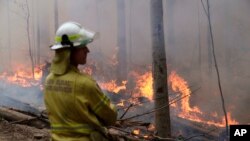The bushfire crisis in Australia has prompted questions about how the world’s driest inhabited continent can fight future blazes in a warmer and still drier climate. Indigenous leaders say that ‘cultural burning techniques’ can help the country become more resilient to wildfires.
A “cultural burn” can also rejuvenate flora, protect native animal habitat and strengthen spiritual ties to the land. Practitioners say Indigenous fire plans, different from other widely used hazard reduction burns, would help to prevent a repeat of this summer’s devastating blazes in Australia.
Aboriginal methods involve the lighting of frequent, small so-called ‘cool’ fires in specific areas during the early dry season between March and July.
The flames burn slowly, reducing vegetation that can feed wildfires. They also create fire breaks.
"Activation of country is exactly what Indigenous burning is. It is activating the landscape to look after the biodiversity and to stop the country burning to nothing," explained Victor Steffensen, an Indigenous fire expert, who says the strategy can make the land more resilient. "The urgency has passed. There are animals that are already extinct, elders have already passed, knowledge already gone to the grave, there is devastating fires around the world, there is sicknesses within the landscapes. What more can I say? We are past our due date but I believe that there is still time.”
Heavy rain has fallen across much of southeastern Australia. For the first time in weeks fewer than 100 bushfires are burning in the states of New South Wales and Victoria. But officials warn the danger is not over, with more hot and windy weather expected later this week.
30 people have died in the fires since September, more than 2,000 homes have been destroyed and an area of land almost the size of England has been scorched.
The disaster has been made worse by record temperatures, a long drought and climate change.










